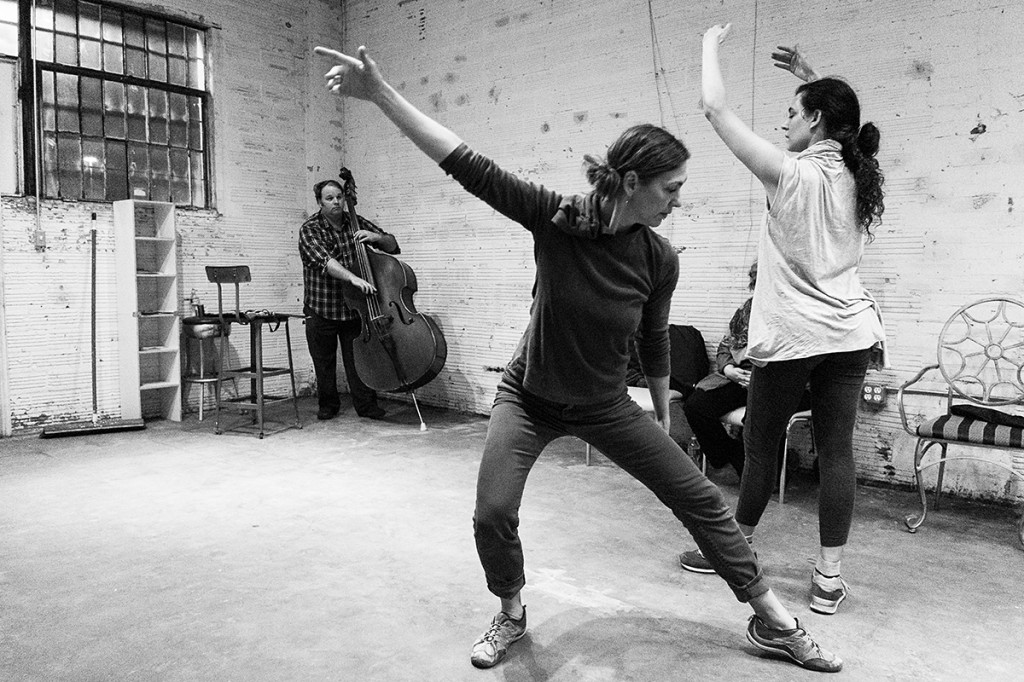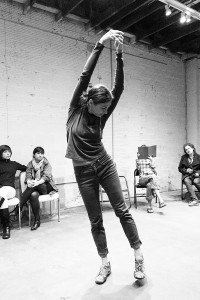They, Who Sound

Hardy and Nance Street Studios. Photo: Lynn Lane
We entered from the back alley/loading dock side of the converted warehouse now known as Hardy and Nance Street Studios. A small,rectangular cement room with chairs set all around the periphery greeted us.
There was no program to prepare us, so we waited until Leslie Scates, dancer, and Damon Smith, upright bass player, entered to spend a few minutes showing us two artists, two artistic mediums, riffing on each other’s impulses. The performers would look to each other expectantly, a tension between leading and following ever present between them.
I’ve often spoken, among friends, about there being different levels of dance viewers. This program was not beginner’s level. There may have been first time dance viewers in the very small audience, and they may have been engaged, but generally, I’ve found that people who are new or even casual dance viewers want more razzle dazzle, more spectacle.
Here, Scates, who is known for her work with improvisation, challenged even experienced audience members with a slowness that often evolved into something fascinating, but you had to wait for it and be willing to let the fleeting moment pass. Walking, stretching, twisting, and slow descents to the floor were her main vocabulary.

Hardy and Nance Street Studios. Photo: Lynn Lane
Smith’s accompaniment included tapping (on the strings with a bow or on the wood of the instrument), scraping six inch bolts stuck in the strings to create resonances, bare fingers squeaking across the wood of the instrument, among other non-traditional ways of playing a bass. The hollowness of the instrument acted as a natural amplifier.
Between dancer and musician, there is little that would be recognizable to anyone who’d only seen music and dance on prime time network TV.
After Scates and Smith finished their duet, they were joined by Philadelphia based dancer Nicole Bindler and trombone player David Dove for a quartet of improvised movement and sound.
The most arresting moments of the evening were when the two dancers were in physical contact. The dynamics moved constantly—cooperation, resistance to strength, giving in to weight, getting tangled up on the floor only to disengage again.
The two musicians performed toward each other from opposite ends of the room. The strings and the horn grated against each other, droning. The occasional gasps of Dove acted as percussive bursts to the aural layers.
After an intermission, we moved to the adjacent room which was, in fact, the loading dock. A plywood platform had been built into the dock. Railings and stanchions around the platform reminded me initially of a boxing or wrestling ring. Bindler and Dove performed a duet on this platform, Bindler moving along and occasionally crossing the rails, moving the stanchions, eventually opening the dock’s garage door and dancing out into the alley. She returned and here she and Dove lost their connection and suddenly it was over, the two laughing about what they were going to do next had the other not stopped.
It was an intimate, raw evening of performance. It felt like the sort of thing that is put on spur-of-the-moment, barely publicized, and attended only by the most daring of art seekers.
It’s the type of event that, though small, seasons a city’s creative scene, giving Houston its own unique flavor and identity in the larger art world.



Recent Comments